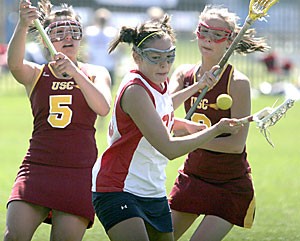First-year coach Jill Toomey had some disappointing news for the Arizona women’s lacrosse club at Tuesday’s practice: Loyola Marymount had to forfeit this weekend’s game.
Another visit by San Diego had to be canceled as well, leaving only one game left on the schedule: a trip to ASU April 7. The pre-practice huddle quickly turned its attention to filling the new gaps in the schedule.
A high school team in Phoenix was looking to play against a college squad. It might have to do.
“”At least it’s a game,”” someone pitched in.
Someone suggested a camping trip. Other players nodded in agreement.
“”Well, we’ve got to do something,”” another said
The season isn’t going to end like this, even if they’re not playing lacrosse.
The cancellations are symptomatic of collegiate club sports. With minimal financing, the monetary burden of travel and equipment costs fall mostly on club athletes.
Smaller sports like lacrosse that can’t afford to make cuts are forced to make exceptions. Sometimes it can be a struggle to field a team, especially when travel is involved.
“”They’re not here to play lacrosse,”” Toomey said. “”They’re here to enjoy school and to enjoy all the other stuff that goes on at school and play lacrosse on the side.””
It’s the blessing and the curse of club sports. Club athletes can find a complete academic and athletic experience in intercollegiate clubs but also bear the burden of administrating the teams themselves.
The nuts and bolts of operating the team fall to the athletes themselves – Arizona’s coaches are on-field only – while study abroad responsibilities, class commitments and part-time jobs all cut into practice time.
“”We’re totally student-run,”” said team president Sarah Doyle. “”We get a little money from the university, but we have to A) ask for it and B) utilize it correctly.””
In addition to the difficulties of maintaining the club itself, the season has been an uphill climb for the team competitively.
Its 2-5 record garners little satisfaction among the athletes, as Arizona’s two victories came from forfeits.
“”I wish we could win a little bit more, but overall it’s fun,”” said sophomore Nicolina Milani-Walker.
“”I’m hoping next year will be a turnaround, and we’ll start winning a lot more games,”” she added.
Meanwhile, Toomey wears a George Mason lacrosse t-shirt to practice. The Maryland native and her assistant coach, Kristy Manas, both played NCAA Division-I lacrosse at the northern Virginia university before moving to the desert to work with the PGA Tour.
Like most club sports coaches, they balance full-time jobs against on-field commitments.
The George Mason logo seems appropriate at practice. Arizona’s small squad of women has every appearance of a Cinderella team operating in the shadow of bigger and better established programs across the Western Women’s Lacrosse League.
Sophomore Allie Taylor describes the team’s struggle as “”exhausting.””
“”Not a lot of people here have been playing for a long time,”” she said. “”There aren’t as many high school programs in Tucson. When we see teams in California they’re more developed. We can’t really compare.””
“”It’s still fun, we have a good time playing, but after a while it kind of beats down on you,”” she added.
Like many club sports, women’s lacrosse literally operates in the shadow of Arizona Athletics, practicing at Bear Down Field with Arizona Stadium looming in the background.
“”We’ve had games scheduled at Murphey (Stadium) for like four months,”” Doyle said. “”Let’s say three days before (a game), and (varsity) soccer decides to take our field. And they can do that, that’s within their reach. We have to overcome things like that.””
Still, there are no hard feelings. Doyle credits Campus Recreation with helping the team in any way they can.
“”If it weren’t for them. I wouldn’t know what I was doing,”” she said.
Still, women’s lacrosse is hanging tough. Three years ago the team was faced with near dissolution as most of the team graduated, leaving only two returning players.
The club had to recruit almost an entirely new roster, including many athletes who had never played lacrosse before.
The team has also faced a revolving door of coaches. At one point, the team was student-coached.
“”For the past five years, it’s been pretty inconsistent. We’ve had almost a new coach every year,”” Doyle said.
However, happier days may finally be around the corner. Both Toomey and Manas plan to return for another year at Arizona, and despite some of the year’s on-field disappointments, there is a palpable sense of optimism at practice among players and coaches.
Toomey, who brings considerable lacrosse savvy to a region of the country where the sport is still in its infancy, is hoping to possibly add another day of practice to the team’s three-per-week schedule.
“”I love to give back to a community that doesn’t know much about the sport yet,”” she said. “”There is a difference on a skill-level basis, but that’s only because of experience. These girls have the same heart and the same passion; they just haven’t been doing it as long.””









